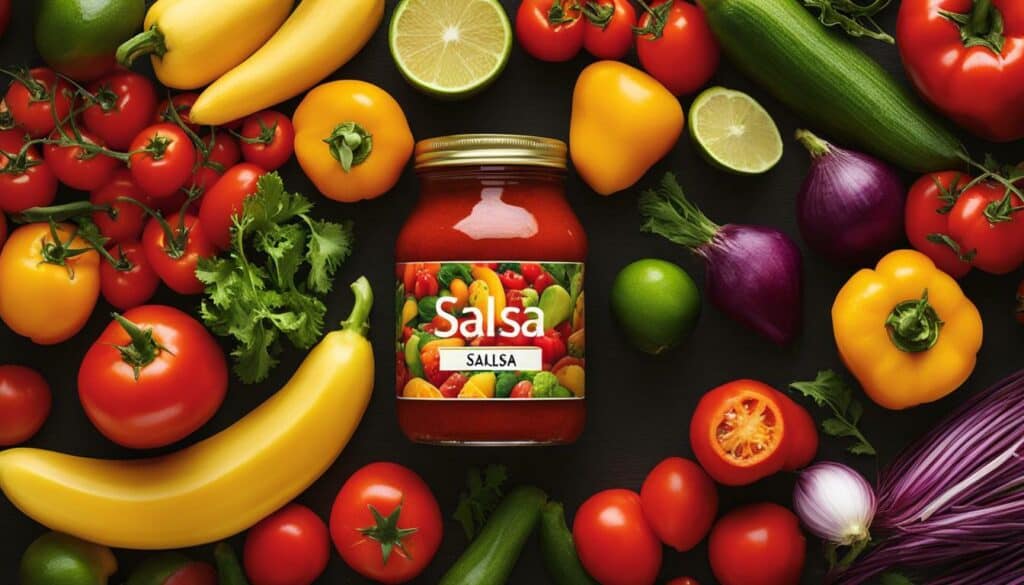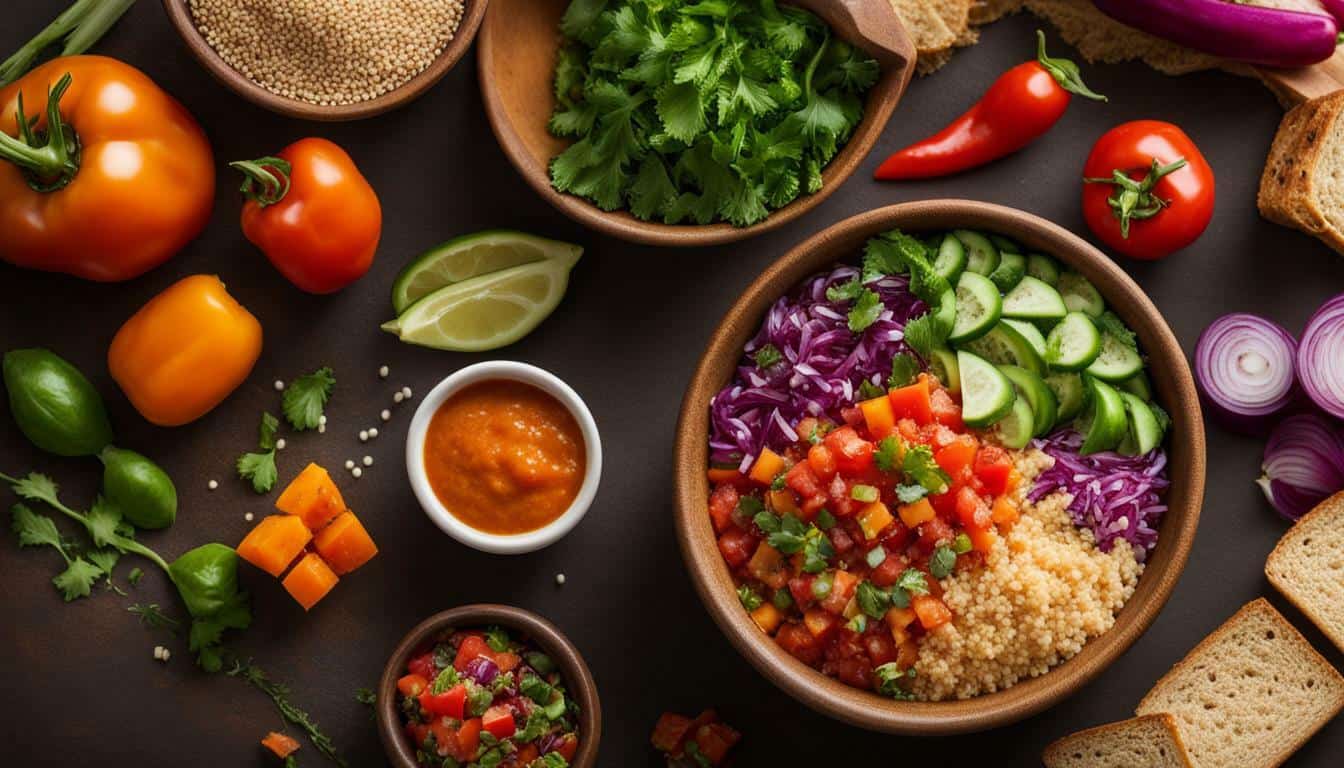Welcome to my tasty guide on salsa carbs! In this article, we will dive into the nutritional information and benefits of salsa, as well as explore how this delicious dip can fit into your healthy eating lifestyle.
- Salsa is a nutritional powerhouse, packed with essential vitamins and minerals.
- It can help stabilize blood sugar levels and support hydration.
- Salsa may have cancer-fighting properties and aid in fat burning.
- It is heart-healthy, low in calories, and rich in potassium and quercetin.
- Salsa is a versatile condiment that adds flavor without adding salt, sugar, or fat.
Now that we’ve covered the key takeaways, let’s explore the nutritional value of salsa in more detail.
The Nutritional Powerhouse of Salsa
Salsa may be a flavorful dip, but it is also a nutritional powerhouse! Packed with essential nutrients, vitamins, and minerals, salsa can add a healthy boost to your meals. Let’s take a closer look at the nutritional value of this delicious condiment.
One of the standout nutritional benefits of salsa is its high vitamin C content. Vitamin C is an antioxidant that helps protect our cells from damage, supports a healthy immune system, and aids in the absorption of iron. Including salsa in your meals is an excellent way to increase your vitamin C intake.
| Nutrient | Amount per serving |
|---|---|
| Vitamin C | 25mg |
| Quercetin (antioxidant) | 12mg |
| Potassium | 100mg |
| Citric Acid | 6mg |
Salsa also contains quercetin, an antioxidant that has been linked to potential anti-inflammatory and anticancer effects. Additionally, it provides a dose of potassium, a mineral that helps maintain healthy blood pressure levels and supports proper heart and muscle functioning. Lastly, the citric acid found in salsa can aid in digestion and promote a healthy metabolism.
Salsa is not only delicious, but it also has some surprising health benefits. It contains antioxidant-rich ingredients like tomatoes, onions, and peppers, which can help protect against chronic diseases like cancer and heart disease. Plus, salsa is low in calories and fat, making it a guilt-free way to add flavor to your meals. So don’t be shy to scoop up that salsa!
Whether you’re dipping tortilla chips or adding it to your favorite Mexican dishes, salsa is a versatile and nutritious choice. It’s an excellent way to add taste and texture to your meals without adding excessive calories, salt, sugar, or fat. So go ahead, grab a jar of salsa, and enjoy its delicious and health-boosting benefits!

If you’re watching your carb intake, salsa is a fantastic choice! With its low carb content, salsa can be enjoyed guilt-free while still adding plenty of flavor to your meals. Not only is salsa delicious, but it also offers a range of health benefits, making it a smart choice for those looking to maintain a healthy eating routine.
Salsa is made primarily with fresh vegetables, such as tomatoes, onions, and peppers, which are naturally low in carbohydrates. These vegetables are packed with essential nutrients, fiber, and antioxidants that are beneficial for the body. Additionally, salsa is typically seasoned with herbs and spices, adding even more flavor without adding unnecessary carbs.
When it comes to salsa, the possibilities are endless. Whether you enjoy it on its own with tortilla chips, as a topping for grilled chicken or fish, or as a flavorful addition to salads and wraps, salsa can elevate any dish without sabotaging your low carb lifestyle.

| Salsa Brand | Carb Content per Serving |
|---|---|
| Brand A | 3g |
| Brand B | 2g |
| Brand C | 1g |
When choosing salsa, be sure to check the nutritional information and choose brands with lower carb counts. The table above provides an example of carb content per serving for different salsa brands. By opting for low carb salsa options, you can enjoy the flavors you love while keeping your carb intake in check.
Salsa: The Flavorful, Low Carb Option
Salsa’s low carb advantage makes it a versatile and delicious condiment for those following a low-carb diet. Whether you’re looking to add some zest to your meals or simply want a guilt-free snack option, salsa is here to satisfy your cravings without derailing your carb goals. So go ahead, enjoy your salsa and savor the flavor!
Understanding Carb Count in Salsa
Wondering what the carb count is in your favorite salsa? Let’s break it down and take a closer look at the carb content of different types of salsa.
Salsa, made primarily from tomatoes, onions, peppers, and spices, is generally low in carbohydrates. However, the carb count can vary depending on the brand and specific ingredients used. It is important to check the nutritional information on the label of your salsa to get an accurate carb count.
To give you an idea, let’s compare the carb content of a few popular salsa brands:
| Salsa Brand | Carb Content per Serving |
|---|---|
| Brand A | 3g |
| Brand B | 2g |
| Brand C | 4g |
As you can see, the carb count can range from 2g to 4g per serving. It’s important to keep in mind that serving sizes may vary, so be sure to check the label for the specific serving size used to calculate the carb count. If you’re following a low-carb diet, opt for salsa brands with lower carb content to keep your carb intake in check.
Remember, salsa is a versatile and delicious condiment that can add flavor to your meals without adding unnecessary carbs. Enjoy it with your favorite dishes, such as grilled chicken or fish, scrambled eggs, or as a dip with fresh vegetables. Incorporating salsa into your meals can be a healthy and flavorful way to enhance your eating routine.

Salsa as a Healthy Condiment
Salsa isn’t just for dipping chips! It can also be a versatile and healthy condiment that adds a burst of flavor to your favorite dishes, without the need for excessive salt, sugar, or fat. Made from a combination of fresh ingredients like tomatoes, onions, peppers, and herbs, salsa is a nutritional powerhouse that can enhance the taste and nutritional value of your meals.
Here are 10 reasons to eat more salsa:
- Vitamin C: Salsa is a good source of vitamin C, which is essential for a healthy immune system and collagen production.
- Blood Sugar Stabilization: The combination of ingredients in salsa, such as tomatoes and onions, can help stabilize blood sugar levels.
- Hydration: Salsa contains high water content from fresh vegetables, helping to keep you hydrated throughout the day.
- Cancer Protection: Some ingredients in salsa, like tomatoes and onions, contain antioxidants that may help protect against certain types of cancer.
- Fat Burning: The capsaicin found in peppers, a common ingredient in salsa, has been shown to boost metabolism and aid in fat burning.
- Heart Health: Many of the ingredients in salsa, such as onions and garlic, have been linked to heart health benefits, including reducing cholesterol levels and improving blood pressure.
- Low Calorie: Salsa is low in calories, making it a great option for those watching their weight or looking for a healthier alternative to high-calorie condiments.
- Potassium: Tomatoes, a main ingredient in salsa, are rich in potassium, which is important for maintaining healthy blood pressure levels.
- Quercetin: Quercetin, found in onions and garlic, has anti-inflammatory properties and may help protect against chronic diseases.
- Citric Acid: Salsa provides a dose of citric acid, which can aid in digestion and enhance the flavor of other foods.
By incorporating salsa into your meals, you can enjoy the benefits of a healthy condiment while adding variety and flavor to your diet. Whether you’re topping your grilled chicken with a fresh tomato salsa or adding a tangy salsa verde to your fish tacos, there are endless possibilities to explore. So next time you reach for the ketchup or mayo, consider adding a spoonful of salsa instead!

| Salsa Recipe | Meal Suggestion |
|---|---|
| Chunky Tomato Salsa | Top grilled chicken or fish with salsa for a fresh and zesty twist. |
| Mango Salsa | Add a tropical touch to your grilled shrimp or pork dishes. |
| Avocado Salsa | Spread on whole-grain toast or use as a topping for tacos or salad bowls. |
Sample Menu
Here’s a sample menu showcasing how salsa can be incorporated into a day of healthy eating:
Breakfast: Scrambled eggs with salsa and whole-grain toast.
Lunch: Grilled chicken salad with salsa dressing.
Dinner: Baked salmon with mango salsa, served with steamed vegetables and quinoa.
Snack: Sliced cucumber with avocado salsa dip.
Remember, salsa is a versatile and flavorful addition to your meals that can elevate your culinary experience while providing essential nutrients. So, get creative in the kitchen and enjoy the benefits of salsa as a healthy condiment!
Salsa and Healthy Eating Patterns
Incorporating salsa into your meals can align with various healthy eating patterns, providing a flavorful and nutritious addition to your daily menu. Salsa is a versatile condiment that can be enjoyed with a range of dishes, making it a convenient choice for those following healthy U.S.-Style, Mediterranean-Style, or Vegetarian Eating Patterns.
The Healthy U.S.-Style Eating Pattern emphasizes consuming a variety of nutrient-dense foods, including vegetables, fruits, whole grains, lean proteins, and healthy fats. Salsa fits perfectly into this pattern as it is packed with essential vitamins and minerals. Its low-calorie content allows you to indulge without compromising your health goals. Try adding salsa to breakfast burritos, grilled chicken salads, or whole-grain wraps for a burst of flavor and nutrients.
In the Healthy Mediterranean-Style Eating Pattern, emphasis is placed on plant-based foods, such as fruits, vegetables, legumes, whole grains, nuts, and olive oil. Salsa, with its abundant vegetables and natural herbs, aligns perfectly with this pattern. Opt for salsa-based dips with whole-grain pita chips, use it as a dressing for Mediterranean-style salads, or complement grilled fish or chicken with a refreshing salsa topping.
If you follow a Healthy Vegetarian Eating Pattern, salsa can be an excellent way to enhance the taste of plant-based meals. Whether you’re enjoying a chickpea and vegetable curry or a tofu stir-fry, salsa can add zing and depth to your dishes. Its low-calorie count makes it a guilt-free addition to vegetarian wraps, sandwiches, and Buddha bowls.
To maximize the benefits of salsa in your meals, remember to choose low sodium options and read the nutritional labels. Experiment with homemade salsa recipes or explore the wide range of commercially available options. With salsa’s versatility and health benefits, it’s easy to see why it has become a staple in many healthy eating patterns.

Here are some sample menus that demonstrate how salsa can be incorporated into different healthy eating patterns:
| Meal | Menu Suggestions |
|---|---|
| Breakfast | Whole-wheat toast topped with avocado and salsa Spinach and tomato omelet with a side of salsa Yogurt parfait with fresh berries and a sprinkle of salsa |
| Lunch | Grilled chicken or tofu salad with salsa dressing Black bean and corn salsa wrap Quinoa and vegetable bowl topped with salsa |
| Dinner | Fish or shrimp tacos with salsa and avocado Vegetable stir-fry with salsa glaze Mexican-style stuffed peppers with salsa topping |
| Snacks | Crispy baked tortilla chips with salsa Vegetable sticks with salsa dip Salsa and guacamole with whole-grain crackers |
Remember to customize these menus according to your dietary preferences and requirements, ensuring a well-rounded and nourishing meal plan. Incorporating salsa into your meals not only adds a burst of flavor but also contributes to a healthy and enjoyable eating experience.
Meal Planning and Budget-Friendly Tips
Planning your meals and being mindful of your budget are important factors in creating a nutritious and budget-friendly meal plan. Let’s explore some tips and tricks to help you make the most of salsa in your planning.
1. Plan your meals in advance: Take some time each week to plan out your meals. This will help you make more informed decisions when grocery shopping and ensure that you have all the necessary ingredients on hand. Consider incorporating salsa into your meal plan as a flavorful and low-cost addition to your dishes.
2. Utilize versatile ingredients: Salsa can be used in a variety of ways, making it a versatile ingredient to have in your pantry. Use it as a topping for grilled chicken or fish, mix it into scrambled eggs, or add it to soups and stews for an extra kick of flavor. By utilizing salsa in different ways, you can create a variety of meals without breaking the bank.
3. Buy in bulk: Purchasing salsa in bulk can help you save money in the long run. Look for larger jars or containers of salsa to get more servings for your dollar. Just make sure to check the expiration date and store the salsa properly to maximize its freshness.
4. Shop for sales and discounts: Keep an eye out for sales and discounts on salsa and other ingredients you regularly use. Stocking up when prices are low can help you save money in the long run. Don’t forget to check online retailers and local farmers markets for deals as well.
Sample Meal Plan
Here’s a sample meal plan incorporating salsa:
| Meal | Recipe |
|---|---|
| Breakfast | Scrambled eggs with salsa |
| Lunch | Turkey wrap with salsa |
| Dinner | Grilled chicken with salsa |
| Snack | Tortilla chips with salsa |
By incorporating salsa into your meal planning, you can add flavor to your dishes while sticking to a budget-friendly meal plan. Remember to adjust portion sizes based on your individual needs and dietary goals.

For more information and resources on healthy aging and nutrition, you can visit the USDA’s MyPlate website, the USDA Center for Nutrition Policy and Promotion, and the USDA Food and Nutrition Information Center.
Delicious Salsa Recipes and Menu Suggestions
Looking for some inspiration on how to enjoy salsa while keeping your meals exciting? Check out these mouthwatering salsa recipes and menu suggestions to add a flavorful twist to your breakfast, lunch, dinner, and snack time!
Breakfast:
Start your day with a zesty kick by adding salsa to your breakfast options. Try a Mexican-inspired omelette by whisking together eggs, diced tomatoes, onions, and jalapenos. Top it off with a dollop of salsa for an extra burst of flavor. If you prefer a lighter option, spread some salsa on whole-grain toast or a breakfast wrap. It’s a refreshing alternative to traditional spreads like butter or jam.
Lunch:
Elevate your lunchtime routine with salsa-infused dishes. Prepare a colorful salsa salad by tossing together your favorite veggies, such as lettuce, cucumbers, bell peppers, and corn. Drizzle salsa as a dressing for a tangy twist. For a heartier option, whip up some salsa chicken wraps. Simply cook chicken breast, shred it, and mix with salsa. Wrap it in a whole-grain tortilla and enjoy a wholesome and delicious lunch on the go.
Dinner:
Bring the fiesta to your dinner table with salsa-based entrees. Impress your guests with chicken fajitas marinated in a zesty salsa sauce. Serve them with whole-grain tortillas, grilled peppers, and onions for a festive and flavorful meal. If you’re a seafood lover, try salsa-glazed salmon. Coat fresh salmon fillets with salsa and bake them to perfection. The combination of succulent fish and zesty salsa will leave your taste buds wanting more.
Snacks:
Salsa isn’t just for meals; it makes a fantastic snack option too. Whip up some homemade salsa using fresh tomatoes, onions, cilantro, lime juice, and a touch of jalapeno for a kick. Pair it with whole-grain tortilla chips for a satisfying and guilt-free snack. Another quick and easy option is salsa-stuffed avocado. Cut an avocado in half, remove the pit, and fill the cavity with salsa. It’s a delightful and nutritious snack that combines the creamy texture of avocado with the vibrant flavors of salsa.

With these scrumptious salsa recipes and menu ideas, you can enjoy the flavorful benefits of salsa in various dishes throughout the day. So get creative, experiment in the kitchen, and savor the deliciousness of salsa in every bite!
Conclusion
Salsa is not only a delicious dip but also a nutritious addition to your meals. With its low carb content and wealth of vitamins and minerals, salsa can be a flavorful and healthy choice for anyone looking to enhance their diet.
Here are 10 reasons to eat more salsa: it’s a good source of vitamin C, can stabilize blood sugar, is hydrating, may protect against cancer, helps burn fat, is healthy for your heart, is low in calories, contains potassium, is a good source of quercetin, and provides a dose of citric acid.
Salsa is a healthy condiment that can be enjoyed without limitations and can be used to season food without adding salt, sugar, or fat. Incorporating salsa into your meals is a great way to increase the nutritional value of your food while adding a burst of flavor.
When planning your meals, consider different patterns of healthy eating, such as the Healthy U.S.-Style Eating Pattern, Healthy Mediterranean-Style Eating Pattern, and Healthy Vegetarian Eating Pattern. These patterns emphasize the importance of consuming a variety of colorful fruits and vegetables daily to support healthy aging.
Meal planning is key to creating a nutritious meal plan. Finding budget-friendly foods, considering preparation time, and keeping calories in mind will help you achieve your health goals. The USDA’s MyPlate Kitchen provides a resource for finding healthy recipes and creating personalized food plans to suit your needs.
Some recipe suggestions to incorporate salsa into your meals include 20-Minute Chicken Creole, Five A Day Salad, and Apple Carrot Soup. Remember to include fresh fruits, vegetables, and whole-grain bread in your shopping list for a well-rounded diet.
For more information and resources on healthy aging and nutrition, you can visit the USDA’s MyPlate website, the USDA Center for Nutrition Policy and Promotion, and the USDA Food and Nutrition Information Center. Stay informed, make healthy choices, and enjoy the flavorful benefits of salsa!
FAQ
Q: Is salsa a good source of vitamins?
A: Yes, salsa is a good source of vitamin C, which is essential for a healthy immune system.
Q: Can salsa help stabilize blood sugar?
A: Yes, salsa can help stabilize blood sugar levels due to its low glycemic index.
Q: Is salsa hydrating?
A: Yes, salsa can help hydrate your body as it contains high water content.
Q: Does salsa provide protection against cancer?
A: Some studies suggest that the ingredients in salsa, such as tomatoes and onions, may have cancer-protective properties.
Q: Can salsa help burn fat?
A: Yes, salsa can help burn fat due to its low-calorie content and metabolism-boosting properties.
Q: Is salsa healthy for the heart?
A: Yes, salsa is healthy for the heart as it is low in saturated fat and cholesterol.
Q: How many calories are in salsa?
A: Salsa is low in calories, making it a great option for those watching their calorie intake.
Q: Does salsa contain potassium?
A: Yes, salsa contains potassium, which is important for maintaining healthy blood pressure levels.
Q: Is salsa a good source of quercetin?
A: Yes, salsa is a good source of quercetin, a compound with antioxidant and anti-inflammatory properties.
Q: Does salsa provide a dose of citric acid?
A: Yes, salsa provides a dose of citric acid, which can enhance the flavor of foods and aid in digestion.
How Many Calories are in a Serving of Salsa?
Salsa is a low-calorie option that adds flavor to dishes. However, its calorie content can vary. A single serving of salsa typically contains around 10-20 calories, depending on the ingredients used. Comparatively, the calorie content of 5 oz steak is significantly higher, ranging from 240-400 calories, depending on the cut and cooking method.
Source Links
- https://www.healthline.com/health/food-nutrition/10-reasons-your-body-will-thank-you-for-eating-salsa
- https://www.nia.nih.gov/health/healthy-meal-planning-tips-older-adults
- https://coloradosph.cuanschutz.edu/docs/librariesprovider151/default-document-library/bingo-salsa–detailed-(1st).pdf?sfvrsn=184158bb_0





Leave a Reply